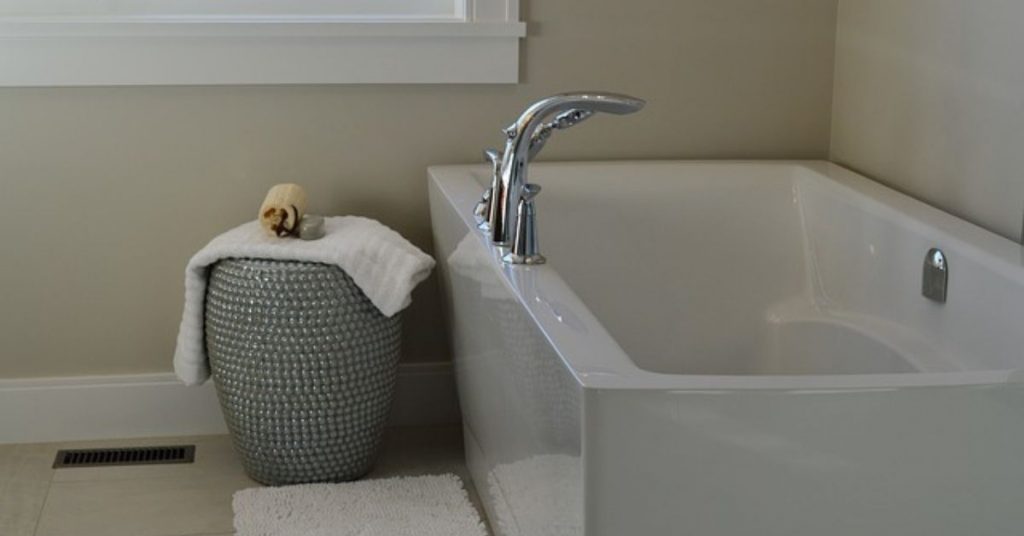Which Bathtub is Better, Acrylic or Fiberglass?
Acrylic and fiberglass bathtubs are 2 of the most common bathtub materials in the market. You will find them in almost all home improvement stores, unlike other high-end types like cast-iron, copper and cultured stone tubs.
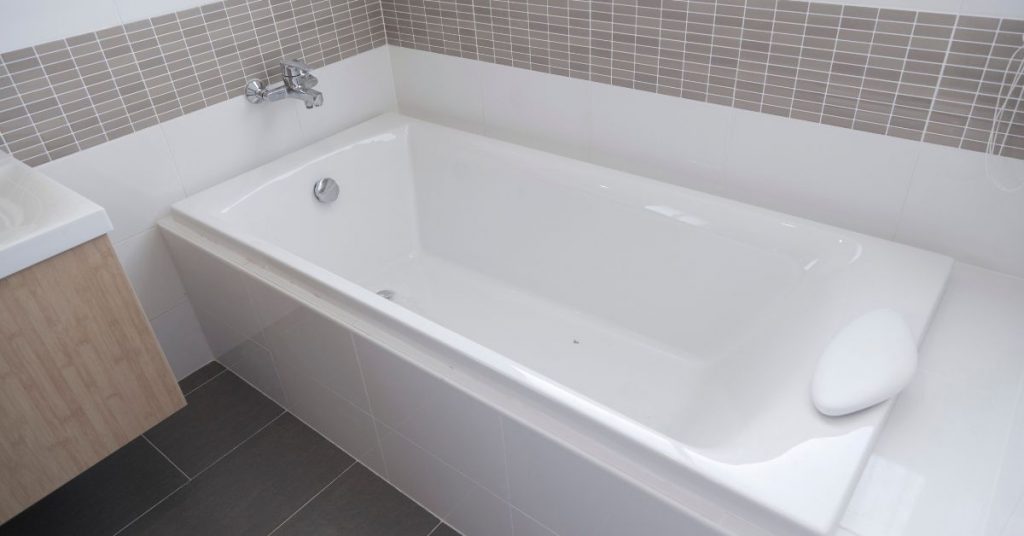
Fiberglass bathtubs are made by molding layers of fiberglass into the desired shape and size and then coating it with a gel resin. Acrylic tubs on the other hand are made by molding an acrylic sheet in the desired shape then the reinforcing them with fiberglass.
Due to the process involved, acrylic bathtubs are stronger, non-porous, have excellent heat retention, are durable and resists scratching, chipping and fading more than fiberglass bathtubs. They are however slightly heavier and more expensive.
Acrylic vs Fiberglass Bathtubs Comparison Table
| Factor | Acrylic Bathtubs | Fiberglass Bathtubs |
| Cost | $500-1500 | $300-500 |
| Weight | 100 pounds | 70 pounds |
| Durability | Durable | Less durable |
| Chipping | No | Yes |
| Scratching | Yes | Yes |
| Variety | Wide | Limited |
| Heat retention | Great | Poor |
| Porosity | Non-porous | Porous |
| Stability | Stable | Less stable |
| Ease of Cleaning | Easy | Hard |
The Pros and Cons of Fiberglass Bathtubs
Here is a table summarizing the pros and cons of fiberglass bathtubs:
| Aspect | Pros | Cons |
|---|---|---|
| Durability | – Resistant to scratches and chipping | – Susceptible to cracking and fading over time |
| Cost | – Affordable compared to other materials | – Can be less durable in the long run |
| Weight | – Lightweight, easy to install | – May flex or feel less sturdy |
| Maintenance | – Easy to clean and maintain | – May discolor or stain over time |
| Installation | – Simple installation process | – Requires proper support and leveling |
| Variety | – Available in various shapes and sizes | – Limited in design and color options |
| Insulation | – Good heat retention properties | – Can feel colder than other materials |
| Repairability | – Relatively easy to repair minor damage | – Difficult to repair major cracks or damage |
| Weight Limitation | – Typically supports average weight | – May not support heavy users or objects |
| Customization | – Can be customized with built-in features | – Limited customization compared to some materials |
What is fiberglass to start with? Fiberglass, which is also known as reinforced plastic is made from molten glass. After the glass is molten, it is then passes through very fine holes to form long filaments and after that several filament strands are wound together to form a glass fiber.
To make a fiberglass bathtub, layers of fiberglass are formed into the desired shape and size and then coated with a gelcoat resin. What are the advantages and disadvantages of a fiberglass bathtubs? Let us start with the advantages/pros.
1. They are Inexpensive
Fiberglass bathtubs are the most affordable bathtubs in the market. This is because fiberglass material is readily available and also the fact that the manufacturing process can be automated, unlike other types bathtubs that are almost 100% handmade.
While fiberglass bathtubs are not the most luxurious tubs in the market, they are not as cost-prohibitive as other tubs. If you do not have thousands of dollars to invest in a bathtub then fiberglass tubs will do just fine.
Fiberglass bathtubs are an excellent option if you are a landlord. Unless you are targeting high-net worth clientele, most tenants won’t mind a fiberglass bathtub. You can also install a fiberglass bathtub if you are looking to sell your house soon. A brand new bathtub will increase your house’s value without breaking the bank.
2. Fiberglass Tubs are Lightweight
Fiberglass bathtubs are also quite lightweight. On average, fiberglass tubs weigh around 70 pounds. A lightweight bathtub has 2 advantages.
To start with, installing a fiberglass is easier than other tubs as it is very easy to maneuver it. It also requires 2 people to do it if you are installing it yourself. A plumber will charge you less to install this type of tub compared to another heavier one like cast-iron tubs.
Another advantage with a fiberglass bathtub is that you can comfortably install it in your upstairs bathroom without the need to reinforce the floor. One thing you must remember about bathtubs is that apart from their own weight, they hold quite a large volume of water which is heavy too.
If you suspect that your floor is not very strong and you do not wish to spend extra cash reinforcing it, you should go with a fiberglass bathtub. You can always buy another one in future when you are ready to renovate your house.
3. Easy/Cheap to Repair
You might be wondering why some bathtubs tends to crack or peel off more than other tubs.. Fortunately, repairing a fiberglass bathtub is very easy and cheaper. This I actually a DIY project hence no need to pay a plumber.
Just grab a fiberglass repair kit and get down to work. According to Home Advisor, the repair can cost anywhere between 20 and 240 dollars depending on the severity of the crack.
The Cons
Fiberglass bathtubs are not without their disadvantages and there are quite a number of them I must stay. Let us look at each of them:
1. They are Brittle
Most people confuse brittle and hardness. Glass is hard but brittle. So what is the difference between brittleness and hardness?
When talking about hardness, you are talking about the amount of force required to deform a material. Brittleness on the other hand refers to the ease of something breaking.
Due to the fact that fiberglass bathtubs are quite brittle, they crack and/or chip off easily compared to acrylic bathtubs.
2. They Flex
Fiberglass bathtubs are structurally weaker compared to acrylic bathtubs. They therefore don’t feel very sold and you will find that with time they tend to flex. Their lifespan is 10-15 years and you will notice that they don’t fell stable especially when they are old.
3. They are Porous
Fiberglass materials are quite porous and will absorb water if not properly cleaned. As you know, a damp surface provides excellent conditions for mold and mildew to thrive. In short, fiberglass tubs are not that easy to clean.
If you don’t like cleaning that much, you should perhaps not buy a fiberglass tub. I don’t think you will be very happy to see mold in the corner of the tub.
4. They fade
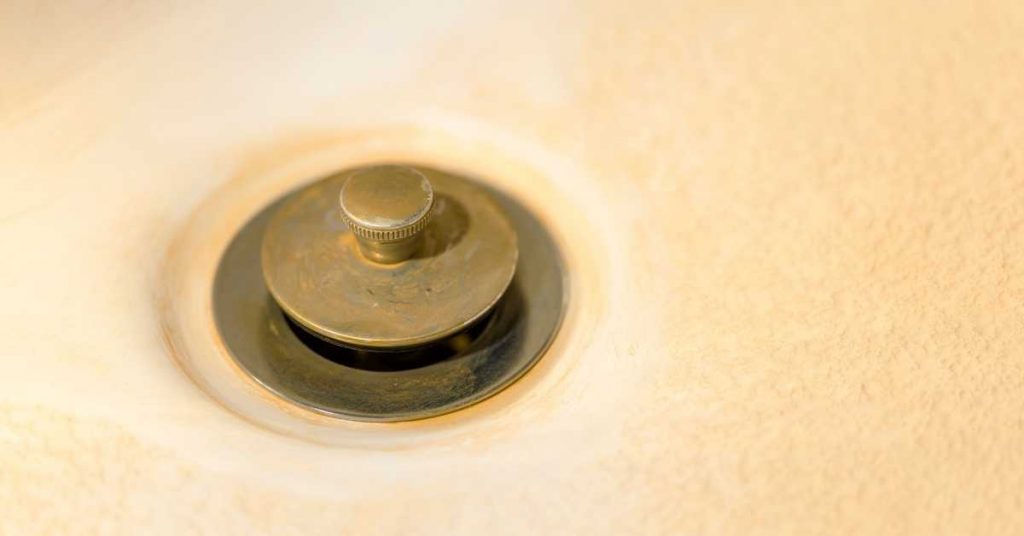
As we have seen in the point above, fiberglass bathtubs need to be cleaned often, and thoroughly. As a result, their color finish does not last that long and will deteriorate with time.
Fiberglass tubs also scratch off quite easily. To honest fiberglass tubs are my least favorite type of bathtub. Unless you are really squeezed for cash I always advise folks to go for acrylic or cast-iron.
The Pros and Cons of Acrylic Bathtubs
Here is a table summarizing the pros and cons of acrylic bathtubs:
| Aspect | Pros | Cons |
|---|---|---|
| Durability | – Resistant to scratches and chipping | – Not as durable as some other materials |
| Cost | – Moderately priced, affordable options | – Can be more expensive than fiberglass |
| Weight | – Lightweight, easy to install | – May flex or feel less sturdy |
| Maintenance | – Easy to clean and maintain | – Prone to scratching if not cared for properly |
| Installation | – Simple installation process | – Requires proper support and leveling |
| Variety | – Available in various shapes and sizes | – Limited design and color options |
| Insulation | – Good heat retention properties | – Can feel colder than other materials |
| Repairability | – Relatively easy to repair minor damage | – Difficult to repair major cracks or damage |
| Weight Limitation | – Typically supports average weight | – May not support heavy users or objects |
| Customization | – Can be customized with built-in features | – Limited customization compared to some materials |
When you don’t have the cash to buy cast-iron, copper or even the more high-end bathtubs but also don’t want to buy the cheaper fiberglass bathtubs, acrylic is the material to settle for. I personally prefer acrylic compared to fiberglass tubs.
Acrylic is a clear/transparent plastic material with amazing strength, stiffness and optical clarity. An acrylic sheet will exhibit glass-like qualities but way lighter than glass and with a very high impact resistance compared to glass.
Acrylic bathtubs are made by bending and molding an acrylic sheet into the desired bathtub shape and size and then reinforced with fiberglass. This means that acrylic bathtubs go through a more “hand-made” process compared to fiberglass tubs which are more or less manufactured.
So what are the advantages and disadvantages of acrylic bathtubs compared to fiberglass bathtubs? Let us start with the advantages/pro.
1. They are Solid
Acrylic bathtubs are more stable compared to fiberglass bathtubs. They are compact, which combined with the qualities of acrylic as outlined above makes these tubs to feel quite solid and stable.
While they are not in the same class as cast-iron tubs, acrylic bathtubs will definitely feel and look better compared to fiberglass tubs even after many years. I should however also add that after years of usage these tubs will also flex, but not to the extent of fiberglass tubs.
2. They are Non-Porous.
Acrylic bathtubs do not absorb water. If you are very keen on hygiene (who isn’t?) or you do not like dealing with mold and mildew (who does?) you will pick an acrylic bathtub over a fiberglass one. If your budget allows it though.
This also means that you can easily clean your acrylic bathtub without the need to use harsh chemicals, which are especially dangerous for folks on a septic system. They are also terrible for the environment.
3. Retain Heat Better
Acrylic tubs are better at retaining bath water temperature/heat than fiberglass tubs. If you like to soak up in the bathtub for a long time then you should invest in an acrylic bathtub.
The thing with a bathtub with poor heat retention is that they are not very energy efficient and as such you have to keep adding hot water to the tub and draining away the cooler water. In essence, you are using more water and hence more power.
To improve their heat retention even more, most acrylic tubs are double-walled. This creates a vacuum that prevents heat transfer from the tub to the surrounding.
4. They are Lightweight
Although not to the tune of fiberglass tubs, acrylic bathtubs are also quite lightweight. On average an acrylic bathtub will weigh about 100 pounds. This makes them easy and cheaper to install.
I really do not think there is a big difference in the installation cost (if any) between acrylic and fiberglass tubs. They can also be installed in the upstairs bathroom without the need to reinforce the floor.
5. They are Durable
An acrylic bathtub will last longer than a fiberglass bathtub. Although both of them will flex after sometime, acrylic tubs do not warp to the extent that fiberglass tubs do.
Apart from the fact that acrylic is a far stronger material compared to fiberglass, acrylic tubs resists cracking and chipping, something that cannot be said about their fiberglass counterparts.
6. Many Options to Choose From
Unlike fiberglass tubs, Acrylic tubs are available in a variety of sizes, shapes and colors. If you are a person who likes to choose from a wide variety then again acrylic tubs are the ones to choose from.
Many of the freestanding bathtubs in the market today are made of acrylic. It is just way easier to mold acrylic into different shapes than fiberglass. This gives you a wide variety of sizes and shapes to choose from.
The Cons
Although acrylic bathtubs have many advantages over fiberglass tubs, they also have their disadvantages. Let us look at a few of them.
1. They are Expensive
Acrylic bathtubs are more expensive than fiberglass bathtubs. On average, fiberglass bathtubs costs between 300 and 500 dollars while acrylic bathtubs costs between 500 and 1500 dollars depending on the size and style. As you can see, some acrylic tubs costs as much as triple the coat of a fiberglass tub.
Clawfoot, freestanding and whirlpool/jetted acrylic bathtubs will surely cost way more than the most expensive fiberglass tubs. As a matter of fact most fiberglass tubs are available for alcove installation only.
2. They Scratch
Although acrylic bathtubs are resistant to cracking and chipping, their finish will fade off or scratch after years of usage. They however do not deteriorate at a faster rate like fiberglass tubs.
On the issue of fading, the bathtub will most depend on the usage. A well taken care of acrylic bathtub will last more than 15 years.
Good Acrylic Bathtubs
The following are 2 of my favorite acrylic bathtubs. One is an alcove bathtub while the other one is a freestanding bathtub.
1. Kingston Brass VTDE603122L 60-Inch Bathtub
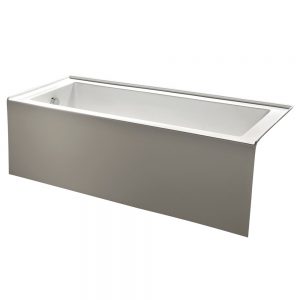
- Type: Alcove
- Tub dimensions: 60 x 30.69 x 22.06 inches
- Style: left-hand drain
- Finish: white
- Water depth: 14 inches
- Wight: 95 pounds
- Capacity: 63 gallons
2. Woodbridge 67″ Acrylic Bathtub
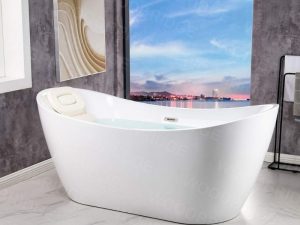
- Type: Freestanding
- Tub dimensions: 67 x 32 x 23 inches
- Style: oval
- Non-slip design
- 59/71-inch models available
- Drain location: center
- Weight: 101 pounds


